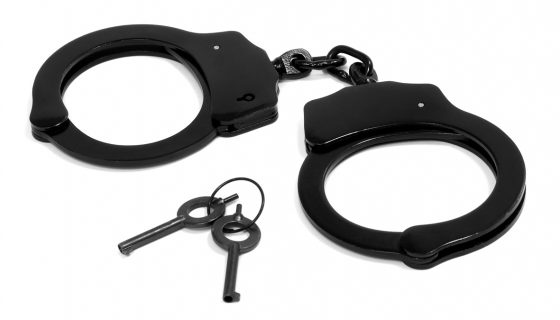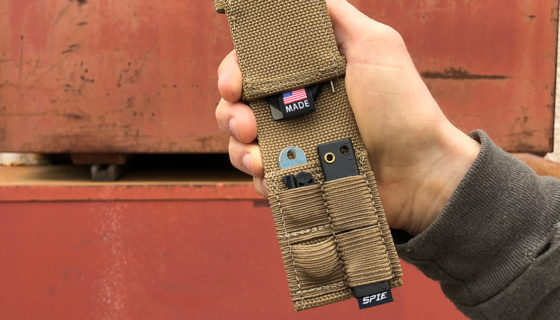Protecting Against Home Invasions
Protecting Against Home Invasions
 With more than hundreds of home invasions happening every year here in the United States, we’d like to present some tips on what you can do to not only protect yourself and your family, but how to fortify your home to better resist becoming a victim.
With more than hundreds of home invasions happening every year here in the United States, we’d like to present some tips on what you can do to not only protect yourself and your family, but how to fortify your home to better resist becoming a victim.
There’s a notable difference between a burglary and a home invasion, that being you. If you’re home, it’s a home invasion. If you’re not, it’s a burglary plain and simple. Criminals don’t always know what they’re walking into during the day, but at night its a different story. Most home invasions happen between 6 p.m. and 6 a.m. on weekdays and weekends.
A criminal that breaks into a residence at night is expecting a confrontation of some kind. Hopefully it will be short lived when you shoot them dead, but as we’ve mentioned before in “Dealing with Violent Confrontations” you should always avoid a confrontation if possible. This is the same in a home invasion scenario, not by using the same methods, but by using some forward thinking to deny criminals the opportunity.
Using the tips we’ll share below will help you in avoiding this kind of confrontation and better protect you and your family.
Analysis of a Criminal
 It’s important to understand how criminals work during a home invasion and some characteristics of these violent offenders. Primarily they target homes where they’re less likely to face resistance and gain access to important information like pin numbers, jewelry, cash, etc. There’s also the chance that these criminals are just looking for a violent confrontation or sexual assault opportunity.
It’s important to understand how criminals work during a home invasion and some characteristics of these violent offenders. Primarily they target homes where they’re less likely to face resistance and gain access to important information like pin numbers, jewelry, cash, etc. There’s also the chance that these criminals are just looking for a violent confrontation or sexual assault opportunity.
Unlike typical burglars, home invasions require homework, and these criminals will spend the time to properly target a person or residence. Most good burglars will watch a home to see when the homeowner is gone, but home invaders will go as far as knowing your daily routine. This will include where you work, where you shop, and where you hang out. All this information will be collected to determine not only the value of their target, but also the resistance they might face.
These criminals could use deception to approach your residence posing as a delivery man, salesman, or even have a woman accomplice to knock on the door why the agressor waits out of sight. This situation would normally occur during the day, and is a technique employed by the criminal as a scout. Always be suspicious of those that you allow into your home, such as the exterminator, carpet cleaner, repair man, etc. If something doesn’t feel right, ask them to leave and request someone else or go with another company. This is also a good time to mention to use a reputable company that’s been recommended to you by someone you trust.
When attempting to enter your residence, home invaders will employ techniques commonly found in CQB (Close Quarters Battle), which are Speed, Surprise and Violence of Action. Speed and surprise are fairly self explanatory, but Violence of Action relates to the overwhelming control these criminal will use to overwhelm their victims and instill fear. This will occur during the first 60 seconds of their initial contact as they’ll be looking to counter any threat they might face.
Working in pairs is to be expected, so remember to always expect that. If you’ve countered one threat there may be more, so always keep your head on a swivel and remember your situational awareness. You have to be prepared to be restrained with duct tape, rope or zip ties if these criminals do get the jump on you. While they shouldn’t if you’re prepared, you need to know how to defeat these restraints when the opportunity presents itself.
Home invasion criminals have been known to be incredibly lazy while ransacking a home, sitting down to eat, taking a nap, etc. All while you’re restrained and forced to watch in disbelief. We’ll avoid cliches like “watching in terror,” because if you’re reading this on ITS, you’ve hopefully adopted a sheep dog mentality and should be rationally thinking about your next move instead of playing the part of the victim.
Ironically, drug dealers are prime targets for home invasions. The abundance of cash, drugs and valuables is highly desired by other dopers and criminals. Not that its a bad thing, and we could all give a crap about them anyway. Whatever is driving the home invader’s motives, this threat is real and one that needs to be taken seriously.
Know Your Neighborhood
 This can’t be stressed enough, only you know when something is awry or out of place, like a strange car parked with multiple passengers inside. Always be cautious of change and shifts in the baseline. If you’re leaving for work in the morning and you see a suspicious car parked around the corner, don’t ignore it. Circle the block and see if its still there when you return. Be a few minutes late for work and blame it on the traffic.
This can’t be stressed enough, only you know when something is awry or out of place, like a strange car parked with multiple passengers inside. Always be cautious of change and shifts in the baseline. If you’re leaving for work in the morning and you see a suspicious car parked around the corner, don’t ignore it. Circle the block and see if its still there when you return. Be a few minutes late for work and blame it on the traffic.
Walking a dog is a fantastic way to know your neighborhood, learning your neighbors patterns, what cars they drive, how many people are typically around a residence, etc. Even jogging is a good excuse to learn the neighborhood. While meeting your neighbors is never a bad thing, letting them know too much about you could be a good thing or a bad thing, depending on how you look at it.
Note what construction vehicles and lawn mowing companies frequent your neighborhood. Don’t be afraid to call the police on a strange person/vehicle that looks out of place. You’d rather look like a paranoid idiot, than regret not preventing something from happening.
As mentioned earlier, better criminals will stake out neighborhoods, observing patterns of when people come and go and when the best time to hit them is. If something feels wrong in your neighborhood, it is wrong. Trust your gut, because if you can’t you’ve got bigger problems on your hands.
Hard Target vs. Soft Target
 While we’ll get into a list of tips further in the article, it’s a good time to bring up the difference between a hard target and a soft target, as this is what criminals are looking for. Think for a minute about businesses and how much security they typically have nowadays. You don’t typically find that same level of security at a household, which makes them softer targets. Police will often patrol businesses and main thoroughfares more than they will neighborhoods.
While we’ll get into a list of tips further in the article, it’s a good time to bring up the difference between a hard target and a soft target, as this is what criminals are looking for. Think for a minute about businesses and how much security they typically have nowadays. You don’t typically find that same level of security at a household, which makes them softer targets. Police will often patrol businesses and main thoroughfares more than they will neighborhoods.
This also applies to individuals, while looking unsuspecting can often work to your advantage, this may be one instance where it won’t. Appearing non-threatening could make you appear to be a softer target in these situations. If this is what you’re going for, great. Also be aware of how you’re dressed because criminals will look for this. Wearing expensive jewelry, watches or driving flashy cars will attract this kind of criminal scum to you, so be cognizant of this when you’re out and about. Obviously, single females are a prime target, so if that’s you, this article is particularly important.
We’re all big advocates of SDRs or Surveillance Detection Routes, and while we’ll get into the depths of this in another article, the path you take back to your vehicle or to your final destination can reveal a lot about what threats could have latched onto you.
A simple SDR you can run while on foot is to walk right past your intended destination and walk a path that you know anyone would be going out of their way to follow. Using storefront glass and other things to note suspicious characters following you is important. Driving is the same thing, take different paths to and from destinations to ensure you haven’t picked up a tail.
Observation is always key anywhere you are, and the primary tool against recognizing threats before they happen.
Protect and Fortify
So how do you fortify your home to become a hard target and take steps to protect yourself? Education and planning are key, so use these steps below and get started!
Home Exterior
- Keep your house well lit at night to discourage would-be criminals. Have motion detecting flood lights on low-lit areas of your home.
- Post stickers and alarm signs on the exterior of your home. Even fake alarm decals and signs can be a deterrent.
- Don’t leave heavy objects in the backyard that can be used to throw through windows, particularly patio furniture.
- Invest in security cameras with motion sensors, IR and a solid recording device like a DVR. The cost on these has come down considerably from what they used to be.
- Make sure your camera recording system is housed in a lockbox so a thief can’t take the record of their crime.
- Internet cameras can also be a good option if you’re away from your home and still need to monitor it.
- At the least, have a zone alarm to alert you when someone is coming to the door or up the driveway.
- Use highly-visible house numbers so that the Police and readily identify your home.
- Lock your gates using a padlock at the least and leave some nice surprises on top of the fence if they think about scaling it.
- Don’t enter your home if it looks like it’s been illegally entered, leave the premises and call the police. Or go full out CQB and clear your house, it’s your call.
- Be aware of the trash you leave on the curb. Break down boxes from recently purchased items like TVs and conceal them from prying eyes and the trash man.
Windows
- Always lock windows, even second floor windows.
- Use secondary locking devices on windows to prevent them from opening past a certain height. Just one more thing to make it more difficult to gain entry.
- Ensure windows have vibration or glass-break sensors connected to the alarm system.
- Consider Solar Screens on your windows which will not only save on your cooling bill, but allow you more privacy and prevent window shopping.
- Solar Screens also are typically screwed into your window frame, which makes removing them more difficult.
- Look at anti-break window film as an option. If you have glass doors, make sure they’re double paned and laminated.
- Fortify basement windows with bars or anti-break window film. Secure windows where A/C units are attached.
- Put a dowel rod in the track of your sliding glass door to prevent it from being opened if the lock is bypassed.
- Secure any skylights or roof-access with upgraded hardware or anti-break window film.
- Be aware of the bushes surrounding exterior windows. Sharp hedges (along with the noise created) will discourage these as entry points.
- Trim your exterior bushes to prevent hiding places and trim tree limbs that allow second story or roof access.
Doors
- Use solid-core exterior doors including the door into your garage, which should also have a deadbolt.
- Get a wide-angle peephole and use it before answering the door, but consider covering it up while not in use. Reverse peephole viewers are readily available.
- Invest in anti-kick door solutions or a police lock to prevent brute force entry. A door chain isn’t going to help one bit, even answering the door.
- Upgrade your locks to high security locks. Bump-Proof locks, Medeco locks and others like them are worth the investment. Most household locks are simple to bypass.
- At the very least you should install longer screws into your door jambs and hinges, preferably 3″ screws.
- Have a spare key hidden in an uncommon place outside your home or better yet, with a neighbor.
Home Interior
- Get a security alarm with interior motion detectors and set the alarm when you’re at home (obviously not the interior motion detector). Criminals rely on an alarm not being set while someone is home and awake.
- Insure your alarm is monitored and will continue to work in the event you loose your power in a storm or it happens to be neutralized. Look into cellular monitoring.
- Have a secondary alarm keypad in your master bedroom that can be used to sound a panic alarm or quickly access alarm controls.
- Have a plan for your family or roommates in your home in the event of a home invasion. Talk it over and know what each person’s responsibilities are. That plan should include ways to escape the home if necessary.
- Consider a safe room as a rally point where you have the ability to protect yourself and call the police. Stash a spare cell phone here.
- Keep your cell phone by the bed ready for you or another person to call 911.
- Keep multiple weapons in places that you’ll likely be taken to in an invasion. Obviously you need to be aware of leaving weapons where children can get to them.
- Have a loaded gun mounted inside the door to your safe. If you’re forced to open it, you’ll be able to give that criminal more than your valuables.
- Get a dog. A barking dog will bring unwanted attention to a potential burglar, but don’t rely on your dog to attack a criminal unless trained to.
- Change alarm codes often and when you have to distribute a spare key, make it to a specific (differently keyed) door in case a key is lost you’ll just have to replace one lock.
- Record serial numbers of expensive items and have backups of your computer off-site using Mozy, Carbonite or in the cloud somehow.
- Mark and engrave your property with your driver’s license number (not social) to aid in returning your stolen property or discourage theft in the first place.
- Discuss the importance of home security with everyone, it only takes one person to forget to lock a door or window.
- Bolt down safes, filing cabinets and lock up expensive items like bikes and four-wheelers.
- Shred all personal documents using a cross-cut shredder. This includes credit card offers, envelopes with the name of your bank, etc.
Vehicles/Garage
- Keep a weapon and tools to defeat restraints concealed in your vehicle. You could be kidnapped and forced to withdraw money from an ATM.
- Keep spare vehicle keys or any important spares in a lock box or safe.
- Always keep the alarm set on your vehicle, even in the garage. Consider a Club or secondary device to prevent theft, even in your garage.
- Having your the keys next to you while you sleep, you can press the car alarm panic button in a pinch.
- Consider disabling the release-cord to your electric garage door opener, particularly if you have garage door windows. If this function is needed you can have something nearby to use.
- Change your factory set garage door opener code, thieves can drive neighborhoods with common openers looking for a doors that they work on.
Skill-Sets
- Learn skill-sets like lock picking and defeating illegal restraints. If the criminal does get the jump on you, have the means to escape when the time is right.
- Buy a gun and seek proper training on how to use it. Become proficient and know it’s limitations.
- Get a concealed carry permit if allowed in your state. Always carry!
- Don’t open carry if allowed. Why show all your cards if you have the option of concealed carry?
- Use PERSEC (personal security) when discussing anything outside of your circle of trust, don’t reveal personal details to anyone who doesn’t need to know. That includes over the Internet and Facebook!
- Letting people know when you’re away from home over Twitter and Facebook is just plain stupid.
- Log all property into a trusted system with serial numbers, photos and even video that is stored off-site.
Closing
Please share this article with your family, friends and loved ones. Warn them of the inherent dangers of home invasions and how to protect against them. Use the resources we’ve created here on ITS Tactical to develop your skill-sets and practice them to stay proficient.
We don’t want to hear any stories of how one of our readers became a victim, rather we’d like to see a news report on you gunning down a criminal during a home invasion. Nothing warms our hearts more than hearing those kinds of stories on the news.
Throw up any useful tips that we may have overlooked and contribute to the information we’ve presented here. The more everyone knows the better prepared we’ll all be.











Discussion